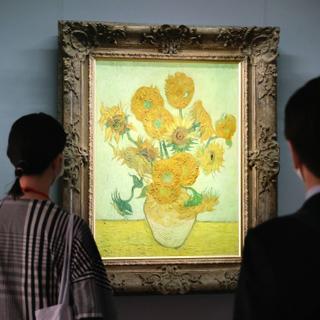


Van Gogh painting looted by the Nazis embarrasses Japan
Long ReadThe US justice system is considering a 'restitution and unjust enrichment claim' against Tokyo's Sompo Museum, owner of the 'Sunflowers' since 1987. Japan is unaccustomed to this type of legal procedure, which is expected to become more frequent.
Painted by Van Gogh in Arles between summer 1888 and January 1889, the seven Sunflowers canvases are scattered across prestigious collections. One is in London's National Gallery, another in Munich's Neue Pinakothek, yet another in Amsterdam's Van Gogh Museum.
Only Japan has ever owned two. The first was destroyed by American bombing in 1945. The second is in Tokyo's Sompo Museum, on the velvet-covered wall of a room dedicated to still lifes, immersed in a silence regularly broken by the click of cell phone cameras.
Yellow petals glistening softly in the subdued lighting, these sunflowers are the stars of this small museum, nestled like a mushroom at the foot of a tree in the skyscraper forest of Nishi-Shinjuku, a business district in western Tokyo. The building houses the collection of businessman Yasuo Gotô (1923-2002), and behind it rise the 43 stories of its parent company, Sompo – one of Japan's leading insurance companies.

On this weekday evening, 40 or so visitors had flocked to see the himawari ("sunflowers" in Japanese), the painting is the object of particular curiosity in a country that admires nature, Impressionism and the figure of the cursed artist.
These visitors may not have realized it, but Van Gogh's Tokyo sojourn is now under threat. This painting is of interest to the American justice system, which is examining a "claim for restitution and unjust enrichment," filed in a Chicago court in December 2022. The plaintiffs – heirs of Jewish Berlin banker Paul von Mendelssohn-Bartholdy – believe that the painting belongs to their grandfather's collection, looted in the 1930s.
Forced sale by Germany
The hundred-odd pages of the highly detailed prosecution dossier accuse the Sompo Museum of having acquired the Van Gogh in 1987, "in defiance of its provenance, notably the forced sale of the painting by Nazi Germany in 1934." The Japanese institution had apparently looked into the legality of its acquisition from the Van Gogh Museum, when it loaned the painting to the Art Institute of Chicago in 2001. The banker's heirs are demanding not only the return of the Japanese Sunflowers, but also $750 million (€675 million) in compensation for the proceeds from the many derivative products marketed by Sompo since 1987. Cotton towels, jewelry, memos and rolls of scotch tape – all decorated with the famous flowers – pack the shelves in the museum store.
"When I heard about the case, I said to myself: 'Finally, Japan is being faced with this type of dispute, a work looted by the Nazis and claimed from a museum'," commented Makoto Shimada, a Japanese lawyer specializing in the art market. While restitution cases are frequent in Europe, they are still rare in Japan.
You have 80% of this article left to read. The rest is for subscribers only.
